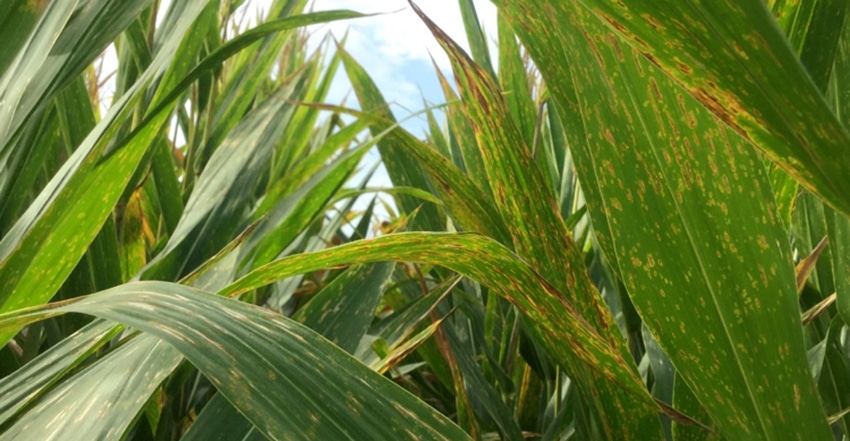
Like many farmers in Illinois, Matt Foes of Bureau County had a heavy disease year in 2018. Tar spot showed up in corn in greater force than ever before, but another, better-understood, fungal infection turned out to be even more common: gray leaf spot.
Gray leaf spot was also the most dominant disease in corn across FMC test plots, which range from Carmi and Champaign in Illinois to Indianapolis and West Lafayette in Indiana.
“In our trials, disease pressure was heaviest in southeast Illinois, but that doesn’t reflect exactly what the growers were up against, because there were [gray leaf spot] hotbeds in certain areas for both states,” says FMC agronomist Nick Hustedde. He adds that the disease prefers moist conditions with temperatures ranging from 75 to 85 degrees F.
He says hybrids known to be susceptible to gray leaf spot, in fields where disease pressure was strong, showed symptoms that gradually developed into pronounced lesions on corn leaves around the V10 to V12 growth stages.
“A lot of our plant pathologists suggest that if you have lesions present on the third leaf below the ear or higher on half the plants ahead of tassel, that’s a good indication that you will see a response from a fungicide trip,” Hustedde says.
Bad scouting year
Stephanie Porter, an agronomist with Golden Harvest, says farmers who go by integrated pest management guidelines to determine when to spray a field to fight disease ran into difficulties in 2018, particularly with gray leaf spot.
“This year was a bad year for scouting. And we’ve had other years like that on our own farm. I want to say in 2016, we went out at a certain time, right before tassel, and we saw no disease, so we didn’t spray,” Porter says. “Then, all the sudden, you get rain and the right conditions, and the disease just blows up.”
She says farmers came to her around the time their crops were at brown silk asking if they should spray fungicide, and she advised them it was too late to help yield, but it could help with standability. She adds that while many farmers are cutting fungicide costs because of lower profit margins, others still spray all their susceptible hybrids if the weather conditions look right.
“It just depends on the operator. But despite the uncertainty in 2018, I still promote scouting,” Porter says. “There’s certain low-lying areas, like down at the river bottoms, where gray leaf spot can blow up horribly — because you don’t necessarily need rain, you need humidity. I cover areas that have irrigation, too, so they’re more prone to spray, as well.”
It’s important to diligently scout susceptible hybrids that can be a bioindicator for what to expect, says Hustedde, adding it’s more of a wait-and-see approach to determine disease progression on moderately resistant or resistant hybrids.
“The less viable leaf area you have, the more carbohydrates the crop has to scavenge from the stalk to fill grain, and that’s where you’re getting into situations where you can see reduced standability and more stalk rots coming in,” Hustedde says.
Spray timing
University of Illinois plant pathologist Nathan Kleczewski conducted fungicide trials on gray leaf spot-infected fields in the 2018 growing season.
He says the VT to R1 growth stage for corn is the ideal time to spray to maximize returns for growers, at least for a lot of the diseases commonly seen in the Midwest.
“If we go in too early, before ear leaves and the cob are starting to develop, or the grain is starting to develop, we don’t see as much of a benefit, because those fungicides might not be protecting foliage in the upper part of the canopy, which contributes most to filling the ear,” Kleczewski says. “Too late, and you’re not protecting all your yield.”
Bureau County farmer Foes says he waits until the R2 growth stage to apply fungicide on corn. He’s fighting both tar spot and gray leaf spot on his fields.
“From tassel emergence until maturity is about 60 days. I try to protect the middle 30 days of that. That’s when stress is at its highest level, environmentally speaking,” Foes says.
He says foliar diseases like gray leaf spot overwinter on residue, and that’s part of the reason some farmers till as part of their management strategy. For his corn-on-corn fields, Foes says he does minimal tillage, so he’s planning on potentially applying a second round of fungicide if weather conditions are conducive for disease.
“I’ve got plans to use hybrids that are thought to be reasonably tolerant, and then I will be aggressive with fungicides, perhaps even making two applications,” Foes concludes. “I’ll be proactive on it rather than cross my fingers and wish for the best.”
About the Author(s)
You May Also Like




